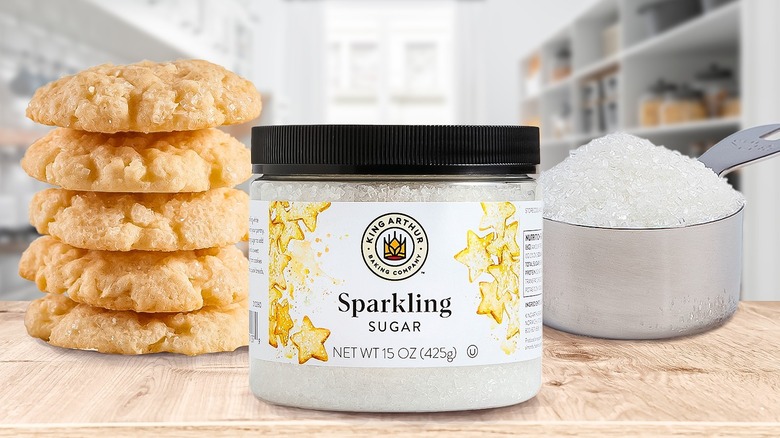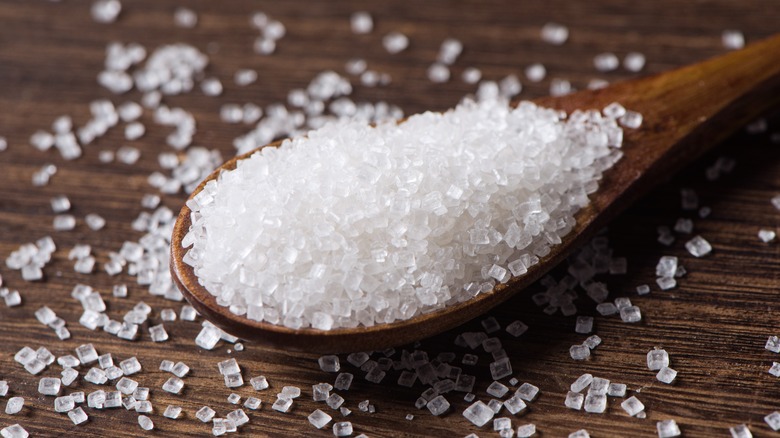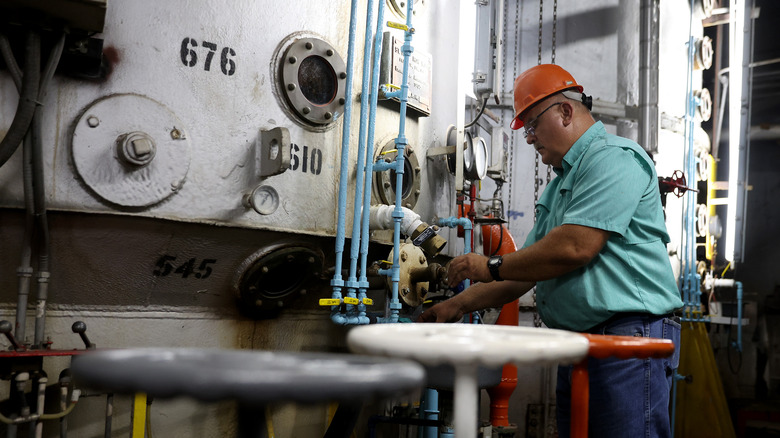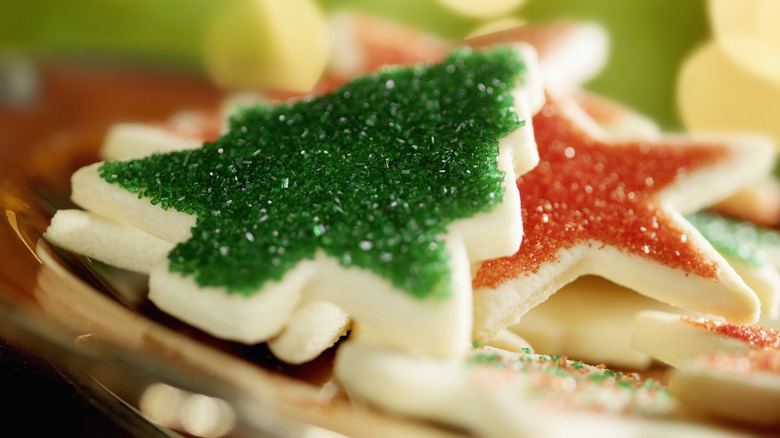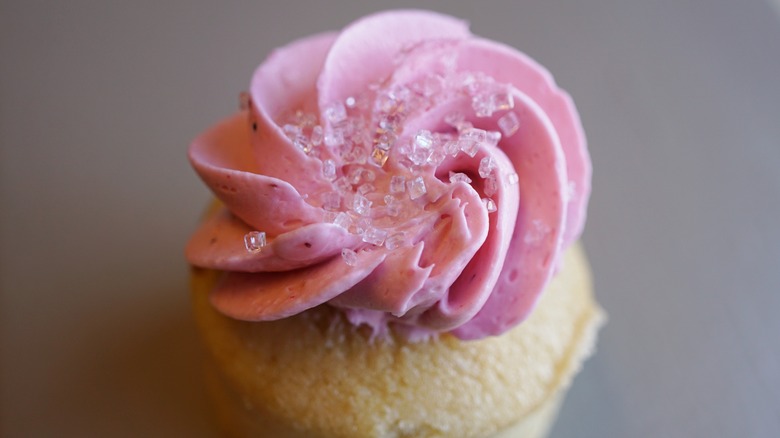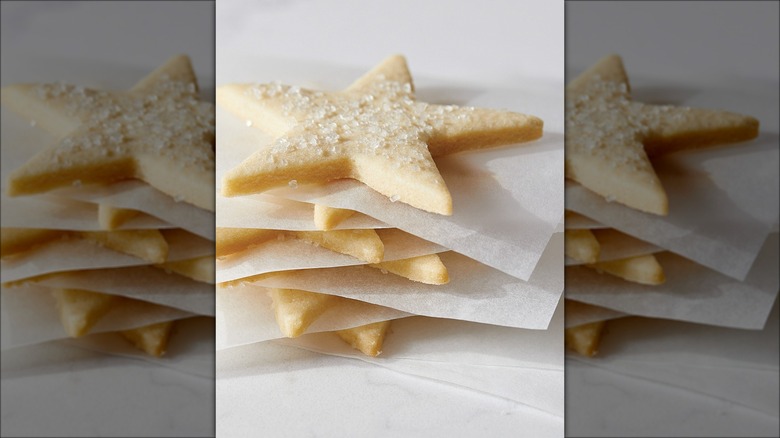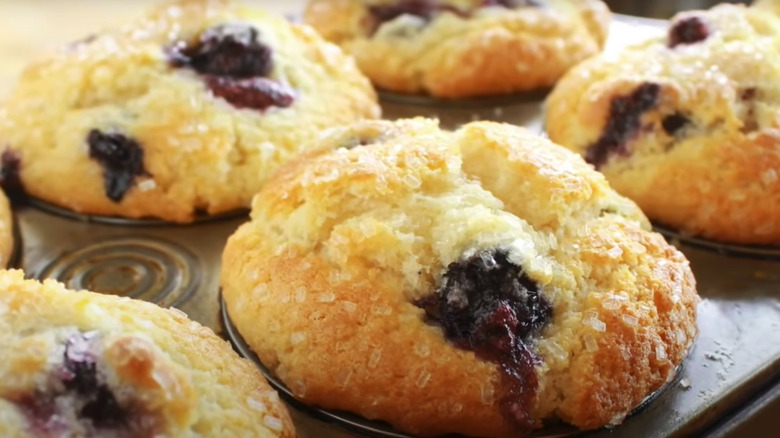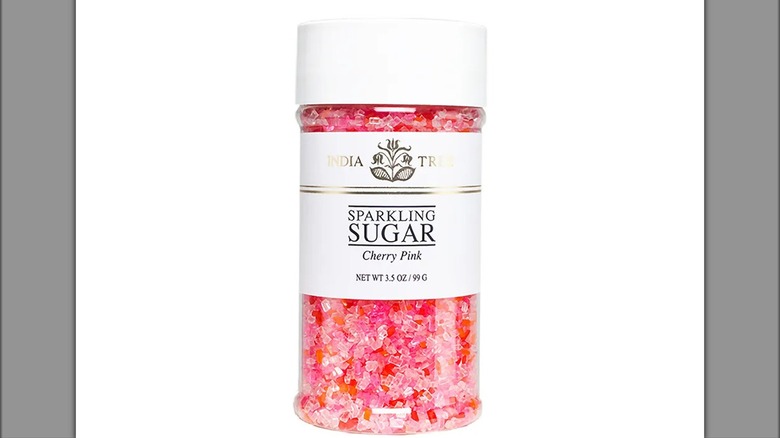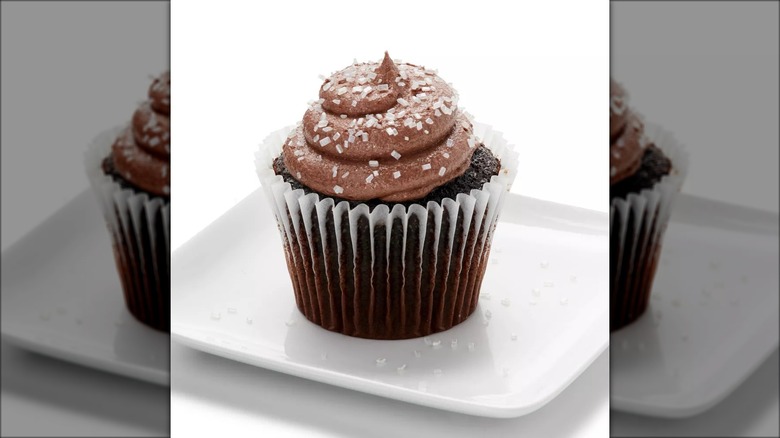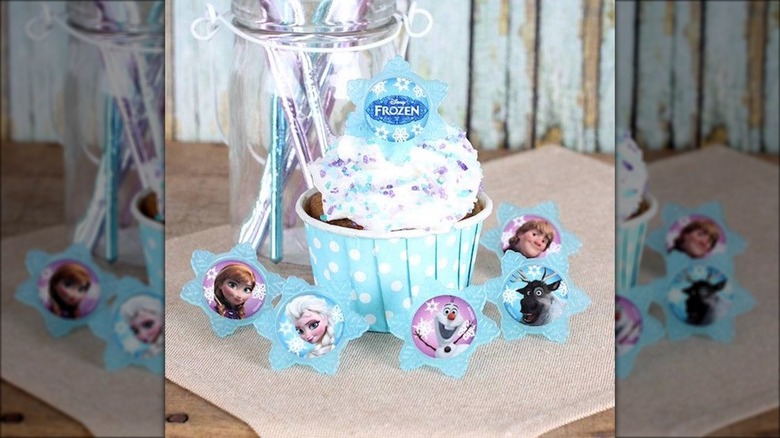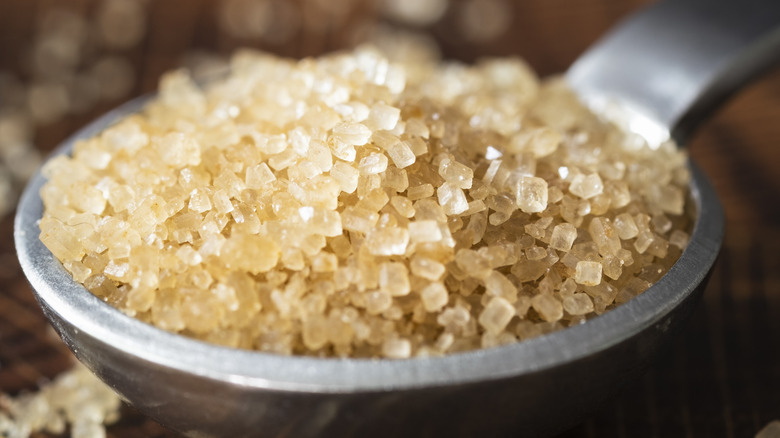What Is Sparkling Sugar And Where Can You Find It?
We may receive a commission on purchases made from links.
We love the experience of stepping into a coffee shop. There's an incredible aroma of fresh coffee and lattes that meets you right at the door. Then, the sight of a pastry case brimming with delectable treats calls to you from the counter. These confections, perfect alongside our chosen cup of joe in the morning, hold a special place in our hearts. We enjoy sweet breads and scores but the bakery muffins always stand out, particularly for their delightful, crunchy topping — a feature we've grown to adore. Often, these tantalizing bits of crunch owe their allure to sparkling sugar, which adds a bright and sparkly, hard-to-miss touch.
Bringing this bakery-style charm into our own kitchens, we've found sparkling sugar to be an absolute game-changer. This type of sugar is unique, not just another sweetener in the baking process. Its role is distinct from the way we use granulated or brown sugar because of the way it behaves, and the beauty of sparkling sugar is that it elevates a wide array of bakery items with its texture and glistening appearance. Once you discover how it enhances the appeal and flavor of your home-baked goodies, you'll understand why this pretty sugar is a must-have sweet ingredient for your pantry. But it's not just about sweetness; it's about adding a sensory experience that turns ordinary baked goods into memorable treats.
What is sparkling sugar?
Sparkling sugar, living up to its enchanting name, is a variety of coarse sugar noted for its shimmering and glossy appearance. Sparkling sugar differs in many ways from granulated sugar, but perhaps most noticeable is its decorative element that adds a whimsical touch to various confections. With its larger, more reflective granules, sparkling sugar also brings a distinctive crunch to any treat it adorns, including the tops of muffins, scones, and cookies.
Unlike finer granulated sugar, sparkling sugar's robust crystals retain their shape and shimmer under an oven's heat, resisting dissolution. This quality makes it especially appealing if you seek to add a touch of glamour and texture to your creations. Whether sprinkled atop frosted cupcakes or dusted over holiday-themed cookies, sparkling sugar enhances the flavor profile and elevates the aesthetic appeal of culinary creations, making them irresistible.
Given its sparkly nature, this type of sugar is often called edible glitter. Of course, there will be times when it doesn't have the same effect as actual glitter, but it does catch that light to offer a little shine.
How is sparkling sugar made?
The fascinating journey of creating sugar, including even sparkling sugar, begins universally with the extraction of sugar juice, regardless of the final sugar type. This process starts with harvesting either sugar beets or sugarcane, the two primary sources of all sugar. After harvesting, these plants undergo a fine, detailed, and thorough preparation process. Sugar beets, for instance, are thoroughly washed, sliced, and then soaked. This soaking is crucial, as it helps extract the sweet juice integral to sugar production.
Once the juice is extracted, it undergoes a purification process to remove impurities, leading to the formation of syrup. The magic of sugar creation unfolds as this syrup slowly crystallizes. These emerging crystals are then spun in a centrifuge, which removes any residual liquid and ensures the purity of the sugar crystals that become the sugar in your pantry.
The journey doesn't end there for sparkling sugar. What sets sparkling sugar apart is its subsequent treatment. Post-crystallization, these sugar crystals are coated with food-grade carnauba wax. It's this final touch that transforms ordinary sugar crystals into sparkling sugar, ready to add that special dazzle to a whole list of sweet creations.
Sanding vs. sparkling sugar
Over and over, we see companies call sanding sugar completely interchangeable terms. While they may seem similar, a closer examination reveals that sanding sugar typically features a much finer grain, akin to the texture of sand, and sparkling sugar boasts a larger crystal size, contributing to its unique appearance and texture.
The finer grains of sanding sugar lend only a minimal crunch to baked goods, creating a subtler effect. This type of sugar is excellent for providing a delicate sweetness and a light sparkle but without the pronounced texture of its counterpart. We like using them to add a lot of color to sugar cookies. On the other hand, the larger crystals of sparkling sugar result in both a noticeable crunch and a pronounced visual sparkle.
Sanding and sparkling sugars can come in various fun colors, extending beyond the traditional white. This brings another dimension of creativity to baking projects. However, when selecting sugar for your baking endeavors, it's crucial to consider the desired texture and visual effect. If the sugar granules are fine, like sand, you're looking at sanding sugar, which will subtly enhance your creation. If the crystals are larger and more reflective, then you have sparkling sugar, ideal for a more striking decorative touch. It's important to know the difference since many labels just label both of these types as sanding sugar.
What does sparkling sugar taste like?
The culinary experience of sparkling sugar is more about texture and visual appeal than a distinct taste profile. When it comes to the flavor, both sparkling and sanding sugars contribute minimal taste differences compared to other sugar types. The additional sweetness that sparkling sugar brings is subtle, and not designed to significantly alter the overall flavor of the baked good.
However, the most pronounced aspect of using sparkling sugar is the texture it introduces. The larger crystals of this sugar type provide a noticeable crunch, enhancing the mouthfeel of the confection. This textural element is particularly appreciated in contrast to the softer textures of cakes, muffins, or cookies.
Beyond texture, sparkling sugar also offers a visual treat. Its larger, reflective crystals create a beautiful sparkle, adding a little something extra to baked goods. This visual appeal plays a significant role in the overall sensory experience of enjoying treats dressed up with sparkling sugar in addition to just how it tastes.
How to cook with sparkling sugar
Sparkling sugar, unlike the typical granulated sugar used as a primary ingredient in recipes, often plays a more decorative role, adding a special touch to various dishes and drinks. This sugar type is ideal for embellishing and enhancing rather than serving as a foundational component. We love using sparkling sugar in our cake decorating. When sprinkled over frosting, it not only adds a delightful glimmer but also introduces a textural contrast to the smoothness of the icing. This subtle addition can elevate the visual appeal of a cake, making it look more enticing and festive and even a little snow-like.
For cookies, especially sugar cookies, sparkling sugar adds a sort of winter wonderland effect. Its reflective crystals mimic the look of frost or snow, which explains why it's a popular choice for holiday baking. Adorned with sparkling sugar, these cookies taste delicious and look charmingly seasonal.
Muffins are another perfect candidate for a sprinkle of sparkling sugar and probably our favorite use of sparkling sugar. By scattering these large granules over the top of uncooked muffins before baking, they earn a delightful bakery-like crunch. This addition enhances the muffin's texture, providing a satisfying contrast to the soft interior.
We also love using it as a decorative topping for hot chocolate, adding a bit of crunch and extra sweetness. Sparkling sugar also serves as an elegant rimming sugar for sweeter cocktails, giving them a visual flair and sweet touch.
Does sparkling sugar melt?
A defining characteristic of sparkling sugar, which sets it apart in the world of baking, is its resilience to heat. Unlike some other forms of sugar, sparkling sugar does not melt when exposed to high temperatures in your oven. This key property is what makes it a finishing sugar and allows it to retain its crunchy texture atop baked goods instead of dissolving into the dough or batter. Its ability to withstand the heat of the oven means that it maintains its distinctive sparkle and crunch, adding a special finishing touch to muffins, cookies, and other treats.
This heat resistance shows one other important aspect you'll certainly want to note: Sparkling sugar cannot be used as a direct substitute for granulated sugar. Due to its non-melting nature, it behaves totally differently in recipes. Where granulated sugar would melt and integrate into the batter or dough, contributing to the structure and texture of the baked item, sparkling sugar would remain intact. This means that while it's perfect for adding a decorative and textural element, it won't perform the same functional roles as granulated sugar in a recipe. You'll be completely disappointed with the outcome if you use this as a substitute.
Where to buy sparkling sugar
Most grocery stores sell sparkling sugar, making it accessible for all your baking and decorating needs. For instance, Target offers a selection of specialty sugars under its Favorite Day brand. Among these, you'll find Shimmer Sugar, which embodies the classic characteristics of sparkling sugar with its reflective and coarse granules. Additionally, Target also carries a range of sanding sugars. These are finer in grain compared to the Shimmer Sugar and come in various colors, offering a more subtle decorative touch.
When it comes to online shopping, Amazon offers products from India Tree, a brand known for its extensive range of sparkling sugars. India Tree's collection boasts a variety of unique and vivid colors. One particularly eye-catching option is the cherry pink sparkling sugar, which includes assorted hues of pink and hints of orange for added contrast. This variety can beautifully enhance the visual appeal of your culinary creations, making it a great choice for themed or festive baking.
Additionally, India Tree offers a confetti variety of sparkling sugar. This type is perfect for adding a whimsical and delightful accent to your next batch of Funfetti cupcakes. The colorful specks of this confetti sugar enhance the flavor and bring a festive and fun look to your baked goods. While shopping and selecting your sugar, be sure to watch for granular size. Many sugars will claim to be sanding sugars but actually more resemble sparkling sugar.
Nutritional information about sparkling sugar
When considering the nutritional aspects of sparkling sugar, look at specific brands for detailed information. Take King Arthur's sparkling sugar as an example, The serving size is standardized at one teaspoon. This small but decorative serving contains 25 calories. This calorie content primarily comes from carbohydrates, as the sugar contains six grams of carbs, all of which are sugars. This nutritional profile is typical for a sugar-based product where the carbohydrates come in the form of sugar. Note that even though this is a decorative element, as a sugar, it needs to be treated as such and could be an important factor for someone sensitive to sugar.
The simplicity of ingredients in King Arthur's sparkling sugar is also worth pointing out. It consists of just two components: sugar and carnauba wax. The sugar provides the sweetness and calories, while the carnauba wax, a food-grade wax, is responsible for the sparkling sugar's distinctive shine and texture. Favorite Day's white shimmer sugar has some additional ingredients, including a confectioner's glaze, artificial color, and titanium dioxide for coloring.
Varieties of sparkling sugar
The realm of sparkling sugars is rich with vibrant colors and mixes, making each brand's offerings unique and exciting. A key differentiator among various brands and types of sparkling sugar is the color combination offerings, which can range from subtle and elegant to bold and playful.
Take, for instance, Sparkles Bee Sweet, a brand with exceptionally vibrant colors and themed mixes. This brand caters to specific occasions and holidays, adding a personalized touch to baking and decorating. For Valentine's Day, Sparkles Bee Sweet offers a special line of sparkling sugars that embody the spirit of the holiday and make your sweet treats that much more beautiful. The Be Mine mix, for example, combines romantic reds and pinks with unexpected pops of teal and white, creating a delightful and festive blend perfect for Valentine's-themed sugar cookies.
We were also very impressed by the spooky season offerings. Notably, a beautiful offering for the Day of the Dead features bright pinks, teal, white, purple, orange, black, and lime green. And come winter, there are varieties to make your sugar cookies all the more bright and festive.
Sparkles Bee Sweet also caters to specific interests and themes, such as popular movies. For fans of Disney's "Frozen," it offers a "Frozen" themed sparkling sugar mix. This blend incorporates colors like teal, blue, white, pink, and purple, capturing the icy and magical essence of the movie. Such themed sugars are perfect for birthday parties or themed events for incredible personalized opportunities.
How to store sparkling sugar
As with most food items, proper storage serves as the key to maintaining the quality and longevity of sparkling sugar. The ideal place to store sparkling sugar is in a cool, dry pantry away from any direct sunlight. For convenience and ease of use, opt for sparkling sugar packaging that features a resealable cap. This type of packaging allows for easy access while protecting the sugar from air and moisture. A screw-on cap effectively ensures the sugar remains dry and free from contaminants.
In cases where you purchase sparkling sugar in bulk, often provided in larger bags that make resealing more difficult, it becomes essential to transfer the sugar into an appropriate storage container. An airtight container is crucial to prevent invasive bugs or other pests. These containers preserve the quality of this sweet ingredient in your pantry.
When shopping for storage containers, you can find a variety of options in grocery stores or big box retailers. The key feature to look for is a strong seal, which ensures the container is airtight and capable of protecting its contents effectively. While aesthetics can be a consideration, prioritize functionality and the quality of the seal over how it looks. A practical, well-sealed container will do the best job of keeping your sparkling sugar in optimal condition, ready for your next baking project.
Substitutions for sparkling sugar
While sparkling sugar is popular for its decorative appeal as a finishing sugar, other sugars can provide a similar texture and enhanced flavor profile. It's especially helpful to know about these alternatives in the event your grocery store runs out of or doesn't stock sparkling sugar. Although online shopping helps in these instances, you may need a replacement quickly. If the specific sugar color is not a priority, Demerara and turbinado sugar are excellent substitutes.
Demerara sugar is a less refined sugar retaining a natural, light brown color due to the presence of molasses. This characteristic imparts a distinctive color and contributes to a rich flavor profile reminiscent of brown sugar. The granules of Demerara sugar are larger and crunchier than regular sugar, making it a suitable alternative for adding texture to baked goods like you would with sparkling sugar. However, its light brown color may not be ideal for all types of finishing work.
For an even deeper flavor and color, try turbinado sugar. This sugar has more molasses flavor and a darker color compared to Demerara sugar. Its large, crunchy crystals are similar in texture to sparkling sugar, providing a pleasant crunch and an extra burst of sweetness. While turbinado sugar may not serve the decorative purpose as effectively as sparkling sugar, its rich flavor and texture make it a great addition for enhancing the overall taste and feel of baked goods.
